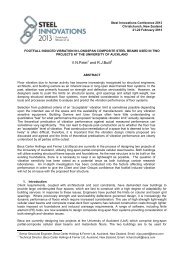Environmental Impacts of Multi-Storey Buildings Using Different ...
Environmental Impacts of Multi-Storey Buildings Using Different ...
Environmental Impacts of Multi-Storey Buildings Using Different ...
You also want an ePaper? Increase the reach of your titles
YUMPU automatically turns print PDFs into web optimized ePapers that Google loves.
- 128 -For the TimberPlus building, there is an even more noticeable impact - net storage <strong>of</strong> carbon,over 630 tonnes <strong>of</strong> CO 2 equivalent. The storage <strong>of</strong> carbon more than cancels out all thegreenhouse gases emitted in the manufacturing process <strong>of</strong> all the other building materials.As shown in Figure 10.2, under this permanent carbon storage scenario, the Timber andTimberPlus buildings have significantly lower net emissions over the full 60 year life-cycle <strong>of</strong>the buildings (data from Table 6.9 and Table 9.3) compared to either conventional, presentdaylandfilling or material reutilisation and recycling.This storage <strong>of</strong> carbon would allow the TimberPlus building to operate for the first 12 yearsas a ‘carbon neutral’ building with no net emission <strong>of</strong> CO 2 .Net storage <strong>of</strong> carbon in wood products is consistent with the idea <strong>of</strong> ‘regenerative building’where the built environment positively repairs the damage <strong>of</strong> previous generations.GWP (t CO2 eq.)8,0007,0006,0005,0004,0003,0002,0001,0000Concrete Steel Timber TimberPlusLandfill scenario w ith decomposition <strong>of</strong> 14% <strong>of</strong> timber after 46 yearsReutilisation / recycling scenarioLandfill w ith 100% permanent carbon storage in timber productsFigure 10.2. Net lifecycle GWP emissions for the four buildings showing comparison <strong>of</strong> different end-<strong>of</strong>lifescenarios.• How important is the choice <strong>of</strong> indicators for an assessment?The comparison between the two end-<strong>of</strong>-life scenarios in Chapter 6 shows that conclusionsbased on a single indicator could lead to unintended outcomes. <strong>Using</strong> the TimberPlus buildingas an example, the results <strong>of</strong> the landfilling scenario would be slightly better in terms <strong>of</strong>climate change. However, looking at the energy results alongside the global warmingpotential results, the reutilisation scenario shows an energy reutilisation benefit, as well asstill being beneficial to climate change. Therefore, the use <strong>of</strong> multiple indicators is necessaryto inform the environmental decision-making processes.
















